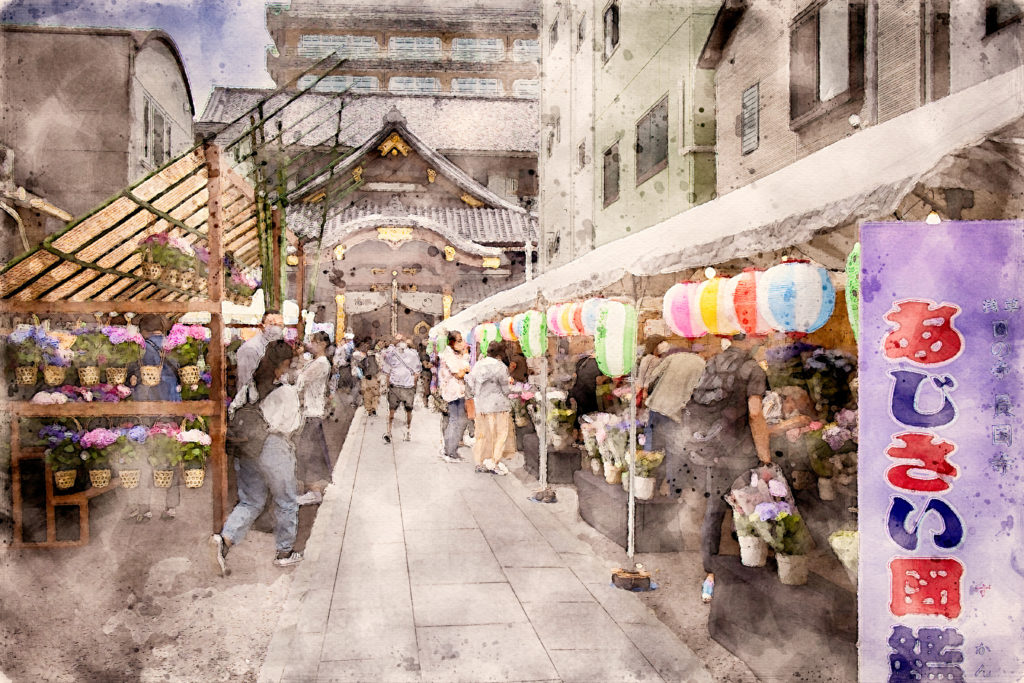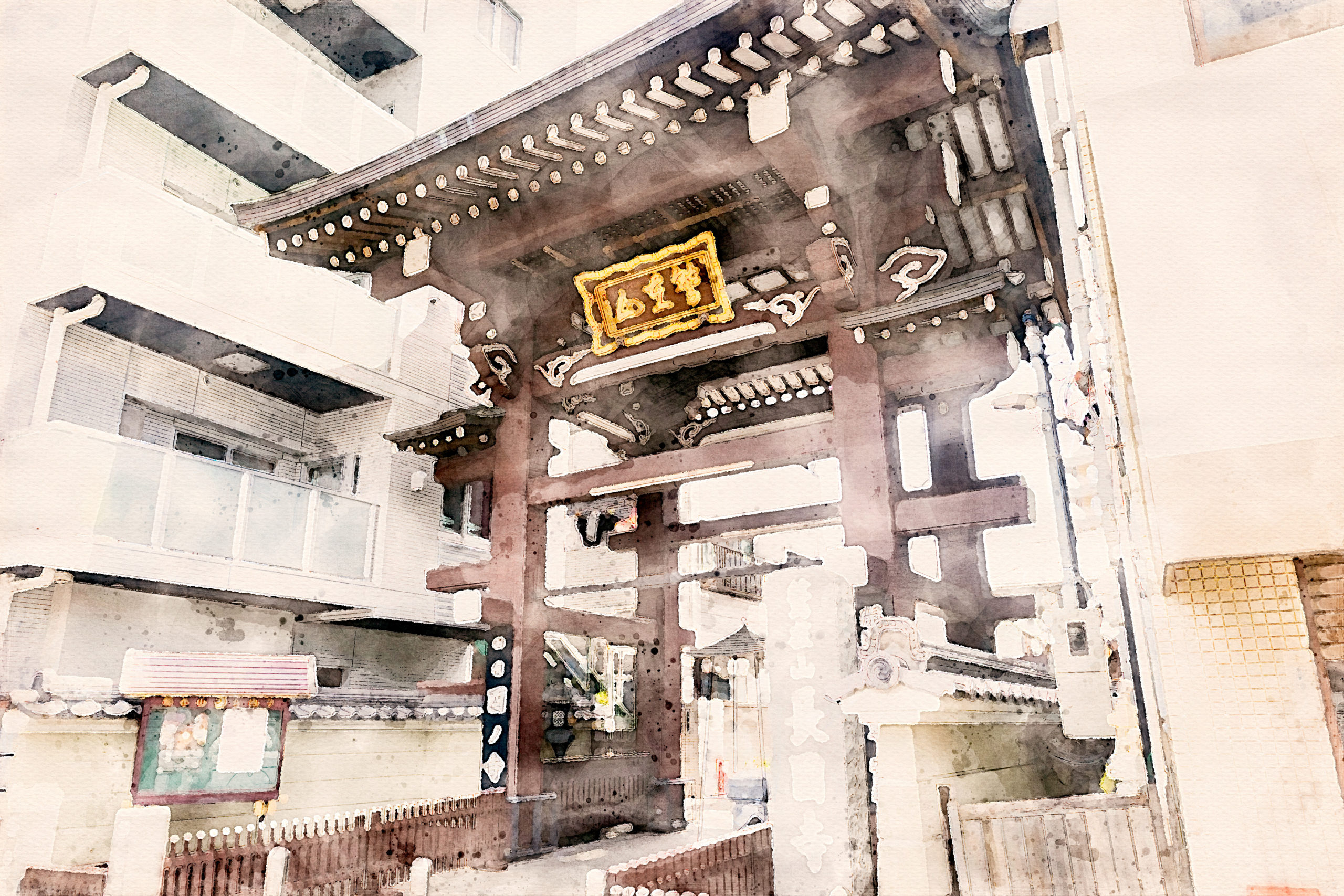Tokyo Shitamachi Guide’s “Shrines and Temples” category introduces Shinto shrines and Buddhist temples in Tokyo’s Shitamachi area (the area along and east of the Sumida River). We select a must-see shrine or temple for your sightseeing in Tokyo.
In this blog post, we will focus on Chokokuji Temple. Chokokuji Temple is a Buddhist temple of the Honmon school of the Hokke sect in Taito Ward, Tokyo.
In addition to Jikkai Mandala (Mandala of the Ten Realms), Chokokuji Temple enshrines Washi Myoken Daibosatsu. This Buddhist deity is also known as Washi Daimyojin (the Great Deity of the Eagle) or Otori-Sama (Lord Eagle).
Near Chokokuji Temple, there is a Shinto shrine named Otori Shrine. Chokokuji Temple and Otori Shrine were originally the same religious entity. Otori Shrine became independent when the Meiji government enforced the Shinbutsu Bunri Policy, which separated Shintoism from Buddhism.
Chokokuji Temple and Otori Shrine jointly hold Asakusa Tori-no-Ichi Fair every November. This is the biggest Tori-no-Ichi Fair in Japan. And this fair is also a year-end tradition in the Asakusa area.
This blog post contains helpful information about Sensoji Temple, such as its history, highlights, and transportation options. Please refer to this blog post when you visit Tokyo’s Shitamachi area, especially the Asakusa area, for sightseeing.
This blog post is also available in Japanese. You can refer to it at the following link:
History
According to Chokokuji Temple, its origin dates back to the 17th century. And its history is closely related to that of the nearby Otori Shrine.
Around 1600, there was a Buddhist monk named Nichiken at Chokokuzan Jusenji Temple. Jusenji Temple is one of the four head temples of the Honmon school of the Hokke sect. And this Buddhist temple is currently located in Mobara Washinosu, Chiba Prefecture.
Nichiken was the 13th chief priest of Jusenji Temple. And some people claim that he was a son of Ishida Mitsunari, a feudal lord in the late 16th century.
In 1630, Nichiken established Chokokuji Temple in Asakusa Torikoecho. Asakusa Torikoecho was the address in the Edo period and was later renamed Asakusa Moto-Torikoecho. At present, it is around Torigoe 2-Chome in Taito Ward.
In 1699, Chokokuji Temple moved to its current location in Senzoku. According to the temple, Sakamoto Den’emon helped the temple with the relocation. The details of this person are unknown.
In 1771, Nichigen, the 13th chief priest of Chokokuji Temple, practiced a ritual called Kanjo to invite Washi Myoken Daibosatsu to Chokokuji Temple from Jusenji Temple.
Washi Myoken Daibosatu is the Buddhist deity who holds a sword and rides on the back of an eagle and is one form of Myoken Bosatsu. And Myoken Bosatsu is the deification of the North Star and the Big Dipper.
Kanjo is originally Shinto terminology and has several meanings. In this case, Kanjo means enshrining the divided spirit of the deity in another place. It is said that the deity’s divided spirit is just as powerful as its original.
Washi Myoken Daibosatsu is also known as O-Tori-Sama (Lord Eagle) or Washi Daimyojin (the Great Deity of the Eagle).
At that time, Chokokuji Temple enshrined Washi Myoken Daibosatsu in Banjin-Do Hall in its precincts. For this reason, this hall was also called Washi Daimyojin no Yashiro or Washi no Miya.
Both Yashiro and Miya indicate Shinto shrines. Therefore, Banshin-Do Hall might have been a Shinto shrine managed by Chokokuji Temple.
In 1868, the Meiji government issued the Shinbutsu Bunri Policy. This policy clearly distinguishes between Shintoism and Buddhism, Shinto deities and Buddhist deities, and Shinto shrines and Buddhist temples.
Because of the Shinbutsu Bunri policy, Chokokuji Temple (a Buddhist temple) can no longer manage Banjin-Do Hall (a Shinto shrine). As a result, Banjin-Do Hall became independent from Chokokuji Temple in 1868. This is the origin of Otori Shrine.
Chokokuji Temple still enshrines Washi Myoken Daibosatsu as its principal image. On the other hand, Otori Shrine enshrines Ame no Hiwashi no Kami, a Shinto deity. This Shinto deity is also known as O-Tori-Sama.
For more details about Otori Shrine, please refer to the blog post below:
Enshrined Deities and Their Blessings
Jikkai Mandala (The Mandala of the Ten Realms)
Chokokuji Temple’s principal image is Jikkai Mandala (the Mandala of the ten realms).
In general, Jikkai Mandala is the principal image for the Hokke sect and the Nichiren sect of Buddhism. Both sects originated with the teachings of Nichiren, a Buddhist monk in the 13th century.
In the center of Jikkai Mandala, you can find the phrase “Namu Myoho Renge Kyo.” And it is surrounded by names of Buddhist deities and Jikkai.
“Namu Myoho Renge Kyo” means “I will believe in and devote myself to the Horenge Kyo (the Lotus Sutra).” “Horenge Kyo” is one of the Buddhist scriptures and is also known as “Hoke Kyo” in Japan.
Jikkai divides our state of mind into the following ten realms of the Buddhist world:
- Buddhahood
- Bodhisattva
- Pratyekabuddha
- Śrāvaka
- Heaven
- Humans
- Asuras
- Beasts
- Hungry Ghosts
- Hell
Washi Myoken Daibosatsu
Chokokuji Temple also enshrines Washi Myoken Daibosatsu as its principal image.
Washi Myoken Daibosatsu is one form of Myoken Bosatsu. It holds a secret sword and rides on the back of an eagle. For this reason, Washi Myoken Daibosatsu is also known as Washi Daimyojin (the Great Deity of the Eagle) or O-Tori-Sama (Lord Eagle).
Myoken Bosatsu is the deification of the North Star and the Big Dipper. Ancient people believed the North Star was the center of the universe and superior to other stars.
Washi Myoken Daibosatsu of Chokokuji Temple has Hagunsei (the star of defeating enemies) on its head. Hagunsei is the Chinese name for the star at the tail of the Big Dipper (Eta in the Great Bear).
In the olden days, people thought of Hagunsei as the deity of war.
They regarded Hagunsei as the tip of a sword and considered its direction unlucky. They also believed that if they attacked in that direction, they wouldn’t lose their war.
For this reason, people believe Washi Myoken Daibosatsu is the deity who guides us in a good direction. Chokokuji Temple enshrines Washi Myoken Daibosatsu as the guardian deity of good luck and happiness.
Highlights
Asakusa Tori-no-Ichi Fair

Asakusa Tori-no-Ichi Fair (the Rooster Day Market of Asakusa) is an annual festival jointly held by Chokokuji Temple and Otori Shrine. This festival has been a year-end tradition in Asakusa since the 17th century.
This fair has the following purpose:
- to thank the god for this year’s safety.
- to pray to the god for happiness and prosperous business in the coming year.
Asakusa Tori-no-Ichi Fair is held on Rooster Days on November every year. The reason for this is related to Nichiren, the founder of the Hokke sect of Buddhism.
While Nichiren was praying for national peace at Jusenji Temple, Washi Myoken Daibosatsu appeared in front of him. It was Rooster Day in November, according to Chokokuji Temple.
Some other Shinto shrines and Buddhist temples hold their Tori-no-Ichi fairs, but Chokokuji Temple’s is the biggest. According to Wikipedia, Asakusa Tori-no-Ichi Fair expects 700,000 to 800,000 visitors every year.
There are two major reasons why Asakusa Tori-no-Ichi Fair became so popular.
- Chokokuji Temple was close to Asakusa and Sensoji Temple.
- There was Yoshiwara Yukaku, a legal red-light district, near Chokokuji Temple.
Firstly, Asakusa was already a major entertainment district in the 17th century. And Chokokuji Temple was a 10-minute walk from Asakusa or Sensoji Temple. For this reason, many people walked from the Asakusa area to Chokokuji Temple’s Tori-no-Ichi Fair.
Secondly, Yoshiwara Yukaku was the largest Yukaku (red-light district) in Japan, located near Chokokuji Temple. Yukkau is where men pay women to have a pleasant evening. Yoshiwara Yukaku is also known as Shin-Yoshiwara.
Yoshiwara Yukaku was totally segregated from the outside. High walls surrounded the precincts. Moreover, Ohaguro-Dobu Moat (a moat with a 9-meter width) surrounded the outside. Such walls and a moat were to prevent women working inside Yoshiwara Yukaku from escaping.
Normally, Yoshiwara Omon (the great gate of Yoshiwara) was the only entrance to Yoshiwara Yukaku. Even though Chokokuji Temple was in the neighborhood of Yoshiwara Yukaku, people had to make a roundabout trip from the temple to the gate.
On the day of Asakusa Tori-no-Ichi Fair, Yoshiwara Yukaku put drawbridges over Ohaguro-Dobu Moat. This made it possible for people to visit Yoshiwara Yukaku from Chokokuji Temple without making a detour. For this reason, many people visited the Yukaku on their way home from the fair.
For more details about Yoshiwara Yukaku, please refer to the blog post below:
Asakusa Hydrangea Fair

Chokokuji Temple holds Asakusa Ajisai Matsuri Fair (Asakusa Hydrangea Fair) every June. This fair is also known as the Summer Tori-no-Ichi Fair.
According to Oku-Asakusa Tourism Association, Asakusa Ajisai Matsuri started in the late Edo period, which is around the 17th century.
One summer, an epidemic spread around Edo (present-day Tokyo). The Edo Shogunate requested that the Chokokuji Temple pray for the abolition of the epidemic. Thanks to that, the epidemic subsided shortly.
Chokokuji Temple started to hold a market in the summer to commemorate this story. This is the origin of Asakusa Ajisai Matsuri Fair.
At Asakusa Ajisai Matsuri Fair, you can enjoy various varieties of hydrangea. The official site of the fair claims that 100 varieties were gathered from all over Japan in 2021.
You can also purchase Kago-Ajisai at Asakusa Ajisai Matsuri Fair. Kago-Ajisai is a potted hydrangea in a bamboo fishing basket. Kago-Ajisai can be purchased only at this fair.
Other Useful Information
Opening Hours
- From 8 a.m. to 5 p.m.
TEL
- 03-3872-1667
Address
- Senzoku 3-19-6, Taito-ku, Tokyo 111-0031
Google Map
Public Transport (Train)
- A 8-minute walk from Iriya Station (Exit #3) on the Hibiya Line
- A 7-minute walk from Minowa Stattion (Exit 1b) on the Hibiya Line
- A 11-minute walk from Asakusa Station (Exit A1) on the Tsukuba Express Line
Public Transport (Megurin Bus)
- A 2-minute walk from Ichiyo-Kinenkan-Iriguchi Stop (Stop #15) on Megurin North Route (Asakusa)
- A 5-minute walk from Taito Byoin Stop (Stop #17) on Megurin North Route (Asakusa)
- A 2-minute walk from Ichiyo-Kinenkan-Iriguchi Stop (Stop #6) on Megurin North Route (Negishi)
- A 5-minute walk from Taito Byoin Stop (Stop #1) on Megurin North Route (Negishi)
- A 5-minute walk from Taito Byoin Stop (Stop #28) on Megurin South Route
Megurin Bus is a community bus service operated by Taito Ward. This bus service is very convenient for sightseeing in Taito Ward. For more information on Megurin Bus, please refer to the blog post below:
Public Transport (Toei Bus)
- A 3-minute walk from Ryusen Stop on Toei Bus Route 都 08 (To 08)
- A 4-minute walk from Senzoku Stop on Toei Bus Route 都 08 (To 08)
- A 3-minute walk from Ryusen Stop on Toei Bus Route 草 43 (Kusa 43)
- A 4-minute walk from Senzoku Stop on Toei Bus Route 草 43 (Kusa 43)
- A 3-minute walk from Ryusen Stop on Toei Bus Route 草 63 (Kusa 63)
- A 4-minute walk from Senzoku Stop on Toei Bus Route 草 63 (Kusa 63)
Public Restroom Availability
- Unconfirmed






